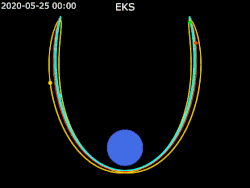Russian early warning satellites
EKS (Russian: Единая космическая система, romanized: Edinaya Kosmicheskaya Sistema meaning Integrated Cosmos System [3]) Kupol (Russian: Купол meaning Dome[4]) is a developing[2] programme of Russian early warning satellites as a replacement for the US-KMO and US-K satellites of the Oko programme.[5]: 7 The satellites are designed to identify any possible future ballistic missile launches, from outer space, and complement early warning radars such as the Voronezh. This gives advance notice of a nuclear attack and would provide information to the A-135 missile defence system which protects Moscow, as well as other Russian missile defense and counterattack resources. Six satellites are planned to be initially orbited.[1] The first of these was launched on 17 November 2015[2] and as of November 2022[update], all six of them are in service.[6]
Background
EKS has been designated to detect and track ballistic missiles launched towards Russia or its allies.[7] The systems have been designed as a replacement for the current system of early warning satellites called Oko, which had its first launch in 1972 [8]: 36 [9] and was described in 2005 as "hopelessly outdated".[10] Oko has two types of satellites: US-KMO are in geosynchronous orbits and have an infrared telescope to identify ballistic missile launches.[11] US-K are in Molniya orbits and are an earlier model with optical telescopes and infrared sensors.[12] The Oko system has two control centres with the main one being Serpukhov-15 outside Moscow.[8]: 40 [8]: 52
Oko is part of the Main Centre for Missile Attack Warning[13] which is under the Space Command (KK) of the Russian Aerospace Defence Forces.[14]
In 2014, Kommersant published that the first satellite, of a type named Tundra, would be launched in 2014. According to that report they would operate on highly elliptical orbits. The satellite was not launched in 2014, however.[15] It was eventually launched from the Plesetsk Cosmodrome on 17 November 2015, using a Soyuz 2.1b rocket with a Fregat stage, under the name EKS-1 / Tundra-11L.[2][16] (GRAU designation: 14F142[17]) In November 2022, the sixth satellite was orbited.[1][6]
Timeline
Information on the new EKS system is scarce but it appears that it was designed by Energia Corp in 1999-2000 and was selected against a proposal from Oko manufacturer NPO Lavochkin.[18] The Russian Ministry of Defence awarded the contract to Energia in 2007 with an expected delivery date of 2008, for a test launch in 2009.[19] In 2009, it was reported to be delayed until late 2011/early 2012.[20] In 2011, the Russian MoD sued Energia for the delay, claiming that a contract extension issued until May 2010 was invalid and asking for 262 million rubles in compensation.[21] According to news reports Energia said that the contract extension was valid and that the problem was with their subcontractors.[21] In addition, they said that the Russian MoD kept changing the specification and demanding things that were beyond the capabilities of the industry.[21] The Russian MoD lost the court case. Energia delivered a satellite in 2009 but as of April 2012 there had not been a test launch.[19]
In April 2012, the minister Alexander Sukhorukov announced that a contract had been signed to manufacture these satellites and that there would be a launch later in 2012.[22] The last satellites of the previous Oko system were Kosmos 2479,[23] launched on 30 March 2012, and Kosmos 2469, launched on 30 September 2010.[24]
The first EKS satellite (Kosmos 2510, EKS-1, Tundra 11L) was eventually launched from Plesetsk on 17 November 2015 using a Soyuz-2.1b rocket[2] and as of May 2020[update] there were four in service which is the minimum standard strength.[25][26] A fifth one was launched in November 2021 to start the expansion of the system capabilities. In November 2022, the initial constellation of six satellites was completed.[6]



